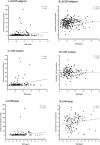Association between Alcohol Consumption and Body Mass Index in University Students
- PMID: 31037273
- PMCID: PMC6484200
- DOI: 10.31372/20190401.1035
Association between Alcohol Consumption and Body Mass Index in University Students
Abstract
Objective: The aim of this study was to determine the correlation between alcohol consumption and body mass index in university students in Eastern Thailand. Methods: Undergraduate students (19-23 years, n = 396) were randomly surveyed via questionnaires, which included general information, alcohol consumption, and unhealthy food consumption. Average daily alcohol consumption was then calculated from grams of ethanol consumed per day. A subject, who has body mass index (BMI) more than 23 kg/m2, was defined as excessive weight. Difference between genders of each variable was compared using independent t-test. Mean of each variable between groups was compared using analysis of variance (ANOVA). The correlation between average daily alcohol consumption and BMI, unhealthy consumption and BMI were analyzed by applying Pearson correlation coefficient. Results: 229 university students consumed alcohol (58%). After 229 subjects were divided into three categories, the average daily alcohol consumption of the overweight group was significantly higher than the underweight and normal weight groups in women; meanwhile, unhealthy food consumption frequencies was not different between groups. Average daily alcohol consumption levels for overweight group were 74.17 and 73.45 g/day in men and women, respectively. Furthermore, higher daily alcohol consumption was independently associated with higher BMI (95% confidence interval [CI] R = 0.161: p = 0.015; men R = 0.120: p = 0.236; women R = 0.214: p = 0.015). Conclusion: There was a positive relationship between alcohol consumption and BMI in university students in Eastern Thailand. This study supports that the daily alcohol consumption is a risk factor for excessive weight and gender may contribute to the correlation.
Keywords: alcohol consumption; obesity; overweight; university students.
Conflict of interest statement
No conflict of interest was reported by the authors of this paper.
Figures


References
-
- Alpert P., & Thomason D. L. (2016). Metabolic syndrome: Differences for Asian Americans is in their percentage of body fat. Asian/Pacific Island Nursing Journal, 1(3), 70–81. 10.9741/23736658.1025 - DOI
-
- Baek S. I., & So W. Y. (2012). Relationship between obesity in Korean adolescents and the frequency of alcohol consumption, the amount of alcohol consumed, and the frequency of severe alcohol intoxication. Obesity Research & Clinical Practice, 6(2), e159–e166. 10.1016/j.orcp.2011.08.001 - DOI - PubMed
-
- Coulson C. E., Williams L. J., Brennan S. L., Berk M., Kotowicz M. A., Lubman D. I., & Pasco J. A. (2013). Alcohol consumption and body composition in a population-based sample of elderly Australian men. Aging Clinical and Experimental Research, 25(2), 183–192. 10.1007/s40520-013-0026-9 - DOI - PubMed
-
- Ding C., Chan Z., Chooi Y. C., Choo J., Sadananthan S. A., Michael N., ... Magkos F. (2018). Visceral adipose tissue tracks more closely with metabolic dysfunction than intrahepatic triglyceride in non-diabetic lean Asians. Journal of Applied Physiology, 125(3), 909–915. 10.1152/japplphysiol.00250.2018 - DOI - PubMed
LinkOut - more resources
Full Text Sources

